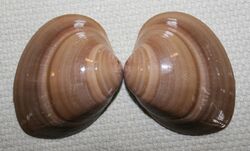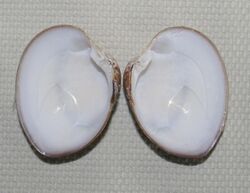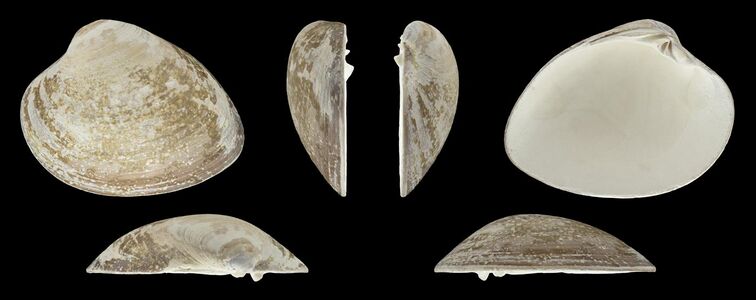Biology:Megapitaria squalida
| Megapitaria squalida | |
|---|---|

| |

| |
| Scientific classification | |
| Domain: | Eukaryota |
| Kingdom: | Animalia |
| Phylum: | Mollusca |
| Class: | Bivalvia |
| Order: | Venerida |
| Superfamily: | Veneroidea |
| Family: | Veneridae |
| Genus: | Megapitaria |
| Species: | M. squalida
|
| Binomial name | |
| Megapitaria squalida (G. B. Sowerby I, 1835)
| |
| Synonyms | |
| |
Megapitaria squalida, the chocolate clam, is a species of bivalve mollusc in the family Veneridae. It was first described to science by George Brettingham Sowerby, a British conchologist, in 1835. The type specimen was collected by Hugh Cuming.[1][2]
Fossil evidence suggests that this species may be as old as 2.5 million years.[3]
Description
The valves are thick and of equal size. In life, the valves are covered by a grayish-brown periostracum. The external surface of the shell is smooth. It is tan to brown in color, sometimes with bands or speckles of different intensity. The interior of the shell is white, sometimes with bands of purple.[4] The shell can reach 120 millimetres (4.7 in) long, 97 millimetres (3.8 in) wide, and 68 millimetres (2.7 in) deep. Weight may reach 93 grams (3.3 oz) for live individuals.[5][6]
Range and habitat
Chocolate clams are found in the eastern Pacific Ocean from Ojo de Liebre Lagoon in Baja California south to Mancora, Peru, and in the Gulf of California. This species is also found in the Galapagos Islands.[7] These clams live buried in sandy sediments from the intertidal zone to 160 metres (520 ft) deep.[6] In a study performed in Magdelena Bay, the average density was 2.01 individuals per square meter.[8] Larger clams are found in deeper water.[5]
Life history
Megapitaria squalida is gonochoric, which is to say that there are two sexes, and individuals are either male or female. Some populations show significantly higher numbers of females than males. Hermaphrodites, individuals containing both types of sex organs, are present, and even common in some populations. One study suggests that differing sex ratios and the amount of hermaphroditism in various populations may be the result of fishing pressures.[9]
Megapitaria squalida reproduces by broadcast spawning. Spawning occurs all year, with seasonal peaks. Oocytes measure between 34.6 micrometres (0.00136 in) and 41.9 micrometres (0.00165 in). Females were observed to contain as many as 1,214 oocytes at any one time.[5]
Chocolate clams are filter feeders. They extend their siphons up through the sand to suck in and expel sea water. They strain out nutrients from the incoming flow and then expel waste products with the outgoing flow.
Chocolate clams can live as long as ten years, while the mode in populations that have been studied is four years.[10]
Human consumption
There are both commercial and recreational harvests of chocolate clams. They are collected by hand on the beach at low tide, by free divers, and by scuba and hookah-equipped divers. The commercial harvest in Mexico grew from 125 metric tons in 1985, to 1,400 metric tons in 2006, and to 4,272 metric tons in 2014.[10] Mexican fishery regulations require chocolate clams to exceed 80 millimetres (3.1 in) in length before they can be harvested.
Chocolate clams are eaten marinated on the half-shell, as ceviche, in chowders, baked, steamed, and in salads.[11]
Chocolate clams are filter feeders and can concentrate heavy metals from the environment. The concentration of heavy metals in clam meat varies by season.[12] Similarly, these animals can sometimes concentrate the neurotoxins of paralytic shellfish poisoning.[13]
Chocolate clams are not actively marketed in the United States. They do not appear on the U.S. Food and Drug Administration's Seafood List.[14]
References
- ↑ Sowerby, G. B. (1835). "February 24, 1835". Proceedings of the Zoological Society of London 3: 23. https://www.biodiversitylibrary.org/item/96158#page/201/mode/1up.
- ↑ MolluscaBase eds. (2020). MolluscaBase. Megapitaria squalida (G. B. Sowerby I, 1835). Accessed through: World Register of Marine Species at: http://www.marinespecies.org/aphia.php?p=taxdetails&id=714777 on 2020-05-01
- ↑ Olsson, A. A. (1942). "Tertiary and Quaternary Fossils from the Burica Peninsula of Panama and Costa Rica". Bulletins of American Paleontology 27 (106). https://archive.org/details/cbarchive_47850_tertiaryandquaternaryfossilsfr9999/page/n1/mode/2up.
- ↑ "Mexican Chocolate Clam" (in en-US). 2017-10-07. https://www.mexican-fish.com/mexican-chocolate-clam/.
- ↑ 5.0 5.1 5.2 Álvarez-Dagnino, Ernesto; Santamaría-Miranda, Apolinar; García-Ulloa, Manuel; Góngora-Gómez, Andrés Martín (2017-04-20). "Reproduction of Megapitaria squalida (Bivalvia: Veneridae) in the Southeast Gulf of California, Mexico". Revista de Biología Tropical 65 (3): 881. doi:10.15517/rbt.v65i3.26371. ISSN 2215-2075. https://revistas.ucr.ac.cr/index.php/rbt/article/view/26371.
- ↑ 6.0 6.1 Keen, A. Myra (Angeline Myra), 1905-1986. (1971). Sea shells of tropical west America : marine mollusks from Baja California to Peru. McLean, James H., 1936- (2nd ed.). Stanford, Calif.: Stanford University Press. ISBN 0-8047-0736-7. OCLC 177510.
- ↑ "Galapagos Species Checklist" (in en-gb). https://www.darwinfoundation.org/en/datazone/checklist.
- ↑ Schweers, Tanja; Wolff, Matthias; Koch, Volker; Sinsel Duarte, Francisco (2014-03-19). "Population dynamics of Megapitaria squalida (Bivalvia: Veneridae) at Magdalena Bay, Baja California Sur, Mexico". Revista de Biología Tropical 54 (3): 1003–17. doi:10.15517/rbt.v54i3.13973. ISSN 2215-2075. PMID 18491642. http://revistas.ucr.ac.cr/index.php/rbt/article/view/13973.
- ↑ Romo, Abril K.; Ceballos-Vázquez, Bertha Patricia; Domínguez, Federico García (December 2009). "Unusual High Frequency of Hermaphroditism in the Gonochoric Bivalve Megapitaria squalida (Sowerby, 1835) (Veneridae)" (in en). Journal of Shellfish Research 28 (4): 785–789. doi:10.2983/035.028.0407. ISSN 0730-8000.
- ↑ 10.0 10.1 Aragón-Noriega, Eugenio Alberto (December 2016). "Model Selection to Describe the Growth of the Squalid Callista Megapitaria squalida from the Eastern Gulf of California" (in en). Journal of Shellfish Research 35 (4): 747–755. doi:10.2983/035.035.0404. ISSN 0730-8000.
- ↑ Masters, Elaine J. (2013-06-30). "Chocolate Clams" (in en-US). https://www.worldfoodist.com/2013/06/30/chocolate-clams/.
- ↑ Méndez, Lia; Palacios, Elena; Acosta, Baudilio; Monsalvo-Spencer, Pablo; Alvarez-Castañeda, Ticul (2006-06-01). "Heavy metals in the clam Megapitaria squalida collected from wild and phosphorite mine-impacted sites in Baja California, Mexico" (in en). Biological Trace Element Research 110 (3): 275–87. doi:10.1385/BTER:110:3:275. ISSN 1559-0720. PMID 16845163.
- ↑ Gárate-Lizárraga, I.; Bustillos-Guzmán, J. J.; Erler, K.; Muñetón-Gómez, M. S.; Luckas, B.; Tripp-Quezada, A. (September 2004). "Paralytic shellfish toxins in the chocolata clam, Megapitaria squalida (Bivalvia: Veneridae), in Bahía de La Paz, Gulf of California". Revista de Biología Tropical 52 Suppl 1: 133–140. ISSN 0034-7744. PMID 17465127.
- ↑ "The Seafood List". https://www.accessdata.fda.gov/scripts/fdcc/?set=seafoodlist&sort=SCIENTIFIC_NAME&order=ASC&startrow=1&type=basic&search=clam.
Wikidata ☰ Q13827657 entry
 |


